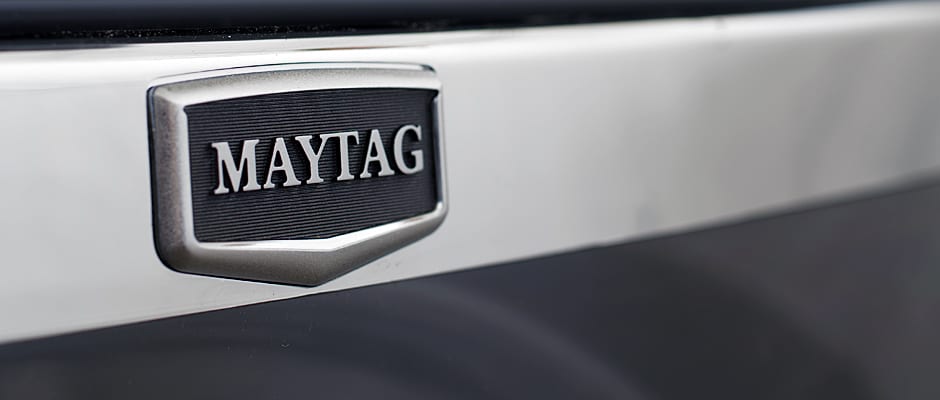Pros
Cons
Introduction
Design & Usability
As much style and grace as you'd expect, with room for improvement.
This particular dryer is visually and structurally identical to the more expensive MED8000AG, with just a small handful of differences compared to the cheaper 6000 variant. Maytag's mysterious-sounding Cosmetallic finish is more or less gray, albeit a shiny, eye-catching (and fingerprint-catching) gray.
The bright white text on the controls pop out from the black background very nicely, but the layout is clunky and overcrowded. Certain sections use smaller fonts, as well, making it potentially difficult to read for some consumers. Charming little tunes and melodic chirps emanate with every button press. Unfortunately, you can only turn off the cycle end chime, not the beeps and honks of the controls, which could lead to some irritating laundry sessions.
Functionality was fine all around: the door was easy to open and shut, cleaning the lint trap was straightforward. The touch-sensitive buttons are quite responsive, while the cycle select knob is easy to turn and feels very stable. "Sturdy" is one word that came to mind when handling this machine, though a strong exterior doesn't always mean good or reliable performance.
{{photo_gallery "Front", "Interior", "Lint Trap", "Cycle Select", "Controls", "Side", "Back"}}
Performance & Features
A good purchase for folks with lots of fragile clothes.
While the overall performance of the MED7000AG was definitely less than stellar, it excelled in one notable way: During the hour and a half Delicates cycles, not only did temperatures remain cool and gentle, but every last drop of excess moisture was removed from our test materials. While a slightly shorter drying time would have been appreciated, this dryer offered up a nearly perfect Delicate cycle.
The rest of the dryer didn't quite impress as much. Its Normal cycle got clothes dry, but it also overheated and ran for too long. Rapid Dry and Bedding—our choices for the standard Quick Dry and Bulky tests—just flat out failed. That said, if you've got a closet full of dress pants and blouses, this machine is going to take good care of you.
A total of ten cycles, five dryness levels, and five temperature settings is pretty much standard for dryers even slightly below this price range. The features won't catch many eyes, either. A damp dry signal, static reduction, steam boost, and control lock are all very much run-of-the-mill features for a mid-range dryer. It's good that they're all there, but for $1,399, we wanted something more.
{{photo_gallery "Cycle Chart"}}
A Farewell to Maytag
Ineffective, limited, and expensive.
Compared to so many other dryers on the market, the Maytag Maxima XL MED7000AG just isn't worth buying. The $1,399 MSRP is way too for the kind of performance it offers, and the best online prices we could find—about $1,160—is still too much.
For about the same amount, you could get one of the best dryers we've ever tested, with improved performance, more cycles, and additional features. Conversely, you could spend much less and get a dryer with equal performance quality. If you're a diehard Maytag fan, though, and absolutely love the new design, you might as well save your money and just go for the 6000. The performance is just as good—better in some cases—and the functional differences are so minimal as to be hardly noticeable.
In the Hot Seat
After running the Maytag Maxima XL MED7000AG through our rigorous set of dryer tests, we compared the results to those of both the 6000 and 8000 versions in the same series. At the end of the day, the numbers don't lie: we have to make the call that this machine is the least effective of the three. It had a truly fantastic Delicate cycle, but on the whole, it took a long time, didn't do a great job with the more specialized cycles, and simply failed to do as well as you would hope for a $1,399 dryer.
Normal & Delicate
Hit or miss depending on your clothes.
The Normal cycle on the Maytag definitely got rid of all the excess moisture from our test load. Of course, it did that while running substantially longer than average and getting rather hot. Peak temperatures reached 149ºF, roughly 10 degrees warmer than we would prefer to see. Temperatures that high can be acceptable, but the Maytag also ran for an average of one hour and 11 minutes. Take high temperatures and mix it in with a duration that's about 20 minutes longer than is typical, and you've got a recipe for over drying.
{{photo_gallery "Normal Test"}}
Oddly enough, the Delicate cycle was as close to perfect as anyone could hope for. Temperatures stayed nice and cool, hitting a high of just 110ºF. True, it did run a little long, averaging 91 minutes between our two test loads, but give temperatures that cool, your clothes should be fine. Ours certainly were: they came out 100 percent dry.
{{photo_gallery "Delicates Test"}}
Quick Dry & Bulky
If you need specialized drying, don't look for it here.
This Maytag has a designated quick cycle called Rapid Dry. It's not a sensor-based cycle, which means you can adjust its length. We ran it for 18 minutes, the initial length that appears when you select the cycle. Unfortunately, our test materials came out having lost just 55 percent of the added moisture, a very poor result. Temperatures had peaked at 122.7ºF; we'd have been happy seeing it get hotter, but it's possible the Maytag simply takes longer to heat up. The user manual states that this cycle is best with loads of just three to four items. Our testing procedure mandates that we use a standardized 4 lb. load, however, so keep that in mind.
{{photo_gallery "Quick Dry Test"}}
The Bedding cycle used for our Bulky test was almost equally poor in its end result. Averaging 56 minutes, our large comforter had lost a mere 57 percent of its excess moisture. High heats of 131.4ºF failed to penetrate to the center of the item, where things stayed much cooler. Most dryers don't do very well with this particular test, but 57 percent is still pretty darn bad.
{{photo_gallery "Bulky Test"}}
Meet the tester
Matthew is a native of Brockton, Mass., and a graduate of Northeastern University, where he earned a degree in English and Theatre. He has also studied at the Gaiety School of Acting in Dublin, Ireland, and spends time pursuing a performance career in the greater Boston and Cambridge area.
Checking our work.
Our team is here to help you buy the best stuff and love what you own. Our writers, editors, and experts obsess over the products we cover to make sure you're confident and satisfied. Have a different opinion about something we recommend? Email us and we'll compare notes.
Shoot us an email

